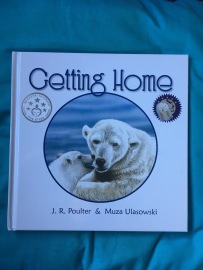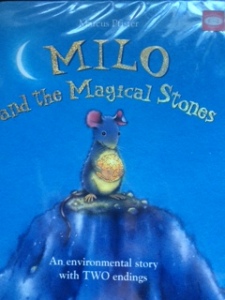Today I am interviewing Jennifer R Poulter and Muza Ulasowski, the author and illustrator of the beautiful story – Getting Home.

How did you come about to illustrate picture books?
I have always been ‘arty’ with it being my favourite subject in high school. Even as a child, I remember telling everyone that I was going to illustrate children’s books!! However, life happened to get in the way – I ended up working as a legal secretary and various other professions instead – eventually, forgetting my dream. After my children graduated from high school though, I went back to college and graduated in 2007 with a Diploma in Graphic Design.
In 2011 I was lucky enough to have received my first publishing contract with New Holland to illustrate the book, ‘Where’s Michael?’ by Xavier Waterkeyn. I enjoyed that process so much, that I have been illustrating children’s picture books ever since. So now, I am very happily living my childhood dream.
How were you able to illustrate these Polar bears so that they would look so life like?
My natural style is hyperrealism. No matter how hard I try, I cannot do simple illustrations. Before I begin to illustrate a character in a book, I research and research and research, downloading hundreds of images via Google. I also visit zoos. For the book Forest Wonder, for example, I spent a lot of time at Lone Pine and also at Australia Zoo photographing the animals and sketching, to get a feel of their movements. I definitely used up my annual passes to both places!! With Getting Home, I visited Sea World many times and took photographs of their polar bears.
What was the medium you used for the illustrations in ‘Getting home’?
I use digital illustrating for books, and I work in layers. The reason for this is so that I can move the characters and background around to fit the text in comfortably – without having to redraw the whole illustration.
I used a combination of Artrage and Photoshop digital programmes via my trusty Intuos 4 tablet or my Cintiq Companion 2 to illustrate Getting Home. I used Artrage because the program is very straightforward and has no “bells and whistles”. It is very similar in technique to using acrylic paints in that once you choose your brush, intensity, medium, colour and transparency – away you go. Each brush stroke is applied individually – just like using acrylic paints – except there’s virtual “water”, no paint spillage and, you never run out of paint. Also, there’s a magical button I like to use a lot – called “delete”!!
Each character is created as a separate illustration, much larger in size than needed so that I can put a lot of detail in each illustration. All the created characters and the background are then combined in a Photoshop file and any touch-ups to colour and shadows are then finalised.
Do you enjoy drawing animals?
I love drawing birds and animals and portraying the tiniest of details. I find it fascinating to try to convey expressions on their faces and though quite challenging, it’s extremely rewarding when I “nail it”.
Your illustrations bring out so much in this story which has such a simple storyline. How do you do this so you can not only draw what has been written but add more to it?
I usually know what I want to draw before I start, but the pictures tend to change and evolve as I go. Sometimes it feels as though the animal characters totally take over – dictating to me what should happen on the page and what else is going to be happening on the page. Usually this happens once I am halfway through a book, and then I have to go back and amend or add to what I’ve previously drawn. So the stories evolve as I go further into the book with sidelines being added to the story.
Do you discuss much of your work with the author?
J.R.Poulter: “Getting Home” was a collaboration. Muza and I spent over a year to and fro-ing ideas, modifying images, modifying text till we had a cohesive whole that we knew ‘worked!’
Muza: Getting Home took an extraordinarily long time to develop…. when I look at the original roughs, the final one looks like a totally different book. There were lots and lots and lots of emails between Jennifer and I and a lot of collaboration changing, editing, deleting, redrawing…. it took over a year to get it to where we thought it was just right.
Why is it important that young children are aware of the problems animals face due to human behaviour?
J.R.Poulter: Today’s children, as the next generation of politicians, teachers, writers, researchers etc., are the ones who will work to protect our world and its animal inhabitants or not. It is important that children are taught to respect the world they live in and seek to preserve it for their children. If today’s educators and parents fail to pass on this respect by example as well as by teaching, then we can expect more animal species to become extinct as their habitats disappear, their food sources are cleared, water sources poisoned and the animals themselves hunted to oblivion either literally or by the push of so called ‘progress.’
Do you have any favourite stories that encourage people to act more sustainably in our world?
J.R.Poulter:
“The Trail of the Sandhill Stag” and “Foam Razorback, His Life and Adventures” both by Ernest Thomas Seton – these two books were handed on to me by my grandmother. My mother’s eldest sister gave me a book called “Nanuk” about an Eskimo boy and his family and how they sought to live and work sustainably in their environment.
My grandmother also had a set of books called “People and Places,” which was published before World War I, I believe. It gave wonderful description of the native peoples and their environments and the animals of these then pristine areas.
Thank you both for giving up your time to answer these questions. Maybe we will see another collaboration someday soon.
Muza Ulasowski is a graphic designer and children’s book illustrator based in the leafy western suburb of Brookfield in Brisbane, Queensland. Australia. She is inspired and surrounded by a vast array of local birds and animals who tend to make their appearances in her book illustrations. She shares her life with her wonderfully patient husband, their charismatic bulldog called Charlie and a black magic cat named Basil.
In 2010, she was invited to illustrate her first children’s picture book and enjoyed it so much, that she has been collaborating ever since with Australian and international authors. To date she has illustrated 12 children’s picture books and is currently illustrating several more which will be published in 2017/18. Whilst primarily concentrating on creating digital images for children’s picture books, Muza also specializes in graphic design, designing book covers and book layouts to print ready stage. Currently Muza has illustrated approximately 12 books, with more to be published in 2017 and 2018.
In her spare time she enjoys illustrating in pencil and charcoal, acrylic painting, wildlife photography, sewing, and creating artworks for her colourful and crafty ETSY store.
Qualifications:
- Diploma of Arts – Visual Communication – 1979
- Certificate IV in Graphic Design – 2008
- Diploma of Graphic Design – 2008

Jennifer R. Poulter was a senior education officer with Qld Studies Authority, writing assessment packages for schools and editing material, and was Deputy head of John Oxley Library [SLQ] when she left there to have her brood of 5. She has over 30 children’s and education titles published in Australia, UK, Europe and USA with mainstream publishers and is currently collaborating with over 30 illustrators publishing her work under her imprint Word Wings for Kids. She has won major awards, including Children’s Choice, New Zealand. More books are coming. She loves teaching children the fun to be had with words!
Under J.R. McRae, she writes novels (including YA), award winning literary poetry, short stories and creates artwork.



